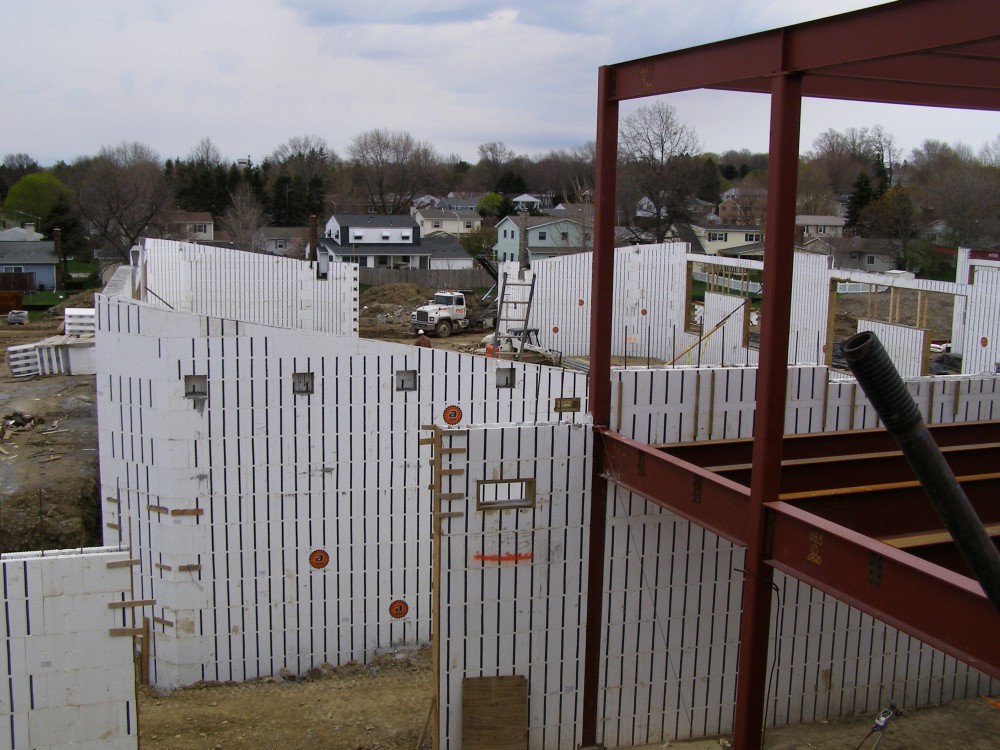Posted on September 03, 2020
Insulated concrete forms (ICFs) consist of concrete sandwiched between layers of expanded polystyrene. EPS is a rigid, closed-cell expanded foam fabricated from beads of polystyrene. ICF forms are so lightweight that they save on transportation costs. Typical R-values of ICFs are about four per inch.
This video details how they work.

Origins of ICFs
Insulated concrete forms (ICFs) were first developed in post-WWII Europe. The repair and rebuilding of damaged structures was a key priority. At first, they were fabricated from cement and recycled wood. These were both available and inexpensive. Modern-day ICFs featuring expanded polystyrene (EPS) construction arrived in the 1960s.
Like graphene and teflon, polystyrene’s discovery was purely accidental. In 1839, Eduard Simon, an apothecary in Berlin, Germany, formed a substance he called “styrol” from natural resin. In the 1920s, Hermann Staudinger discovered that heating styrol caused chain reaction polymerization. For his efforts, the German chemist won the Nobel Prize in Chemistry in 1953. The commercial production of polystyrene commenced in the 1930s.
Onsite Advantages of ICFs
ICFs promote efficient and sustainable construction techniques in a number of ways.
Collapsible
High-density polypropylene ties and brackets are collapsible. Ship-flat transportation is very efficient.
Lightweight
Lightweight
During EPS manufacturing, polystyrene beads expand up to 40 times. As a result, EPS foam is only five percent plastic. The closed-cell foam traps air, a very effective insulator. A five cubic foot tote of EPS weighing 600 pounds produces enough ICF forms to fill a 53-foot trailer. Fox Blocks ICF forms contain 48.5 to 57.5 percent recycled content by weight.
Reduced waste
Universal, reversible ICF blocks generate minimal construction waste. Cut a reversible ICF block in half horizontally, and you can use the top half as well. Save money while simultaneously seeking LEED certification. Logix estimates construction waste at less than one percent.
Recycled content
You’ll find a significant amount of recycled material in most ICF forms. In turn, the components of an ICF wall are readily recycled at the end of its service life. The concrete, rebar, plastic and EPS foam are all recyclable materials. Ties and brackets are often 100 percent recycled polypropylene. ICF forms often contain more than 50 percent recycled content.
ICF Construction Efficiency - One Product: 6 Steps
ICFs are inherently more efficient during construction. For example, ICFs forms eliminate steps required with wood-frame construction. The insulation, air barrier and vapor barrier are integral to the design.
Form system
Once the lightweight ICF forms arrive onsite, it is easy to maneuver them into place. Universal, reversible ICF blocks speed the process.
Wall structure
Wall thickness determines the recommended aggregate sizes. For example, a four-inch ICF might call for an aggregate no larger than 3/8 inch. An eight-inch ICF might call for aggregates in the one-half to the three-quarter-inch range. Slump might range from 6-7 inches for a four-inch ICF to 5-6 inches for a 12-inch ICF.
Insulation
Continuous double-layer insulation typically delivers R-22 values and higher. The thermal mass of the concrete layer further contributes to temperature regulation.
Air barrier
ICFs deliver a solid, monolithic air barrier. This continuous barrier easily exceeds code requirements for airtightness. The continuous air barrier delivers indoor comfort enhanced climate control.
Vapor barrier
ICFs also include a built-in vapor barrier. With wood frame construction, both moisture intrusion and mold are common threats. With ICF construction, you often get PERM ratings of less than 1.0.
Anchorage indoors and out
Get the solid attachment you need, indoors or out. Embedded fastening strips will work with siding, brick and other finishes.
Recent ICF Projects in Pennsylvania
The construction efficiencies of ICFs make them popular for many projects. Retail centers, medical clinics, hotels, houses of worship and theaters are some examples. Thanks to the longevity of ICF construction, positive life cycle assessments are common.
Ward’s Ridge - Newcastle
Ward’s Ridge is a 28,000 sqft office park in New Castle, a western PA community located south of Interstate 80. Two of the three structures feature ICF wall systems. The $5.5 million project was a 2019 Heavy Commercial Finalist in the ICF Builder Awards. This is a global competition recognizing the best in ICF construction.
Ward’s Ridge is an excellent case study in ICF vs. stick-framed construction. At first, all three structures were to be wood-frame. In the pre-construction phase, two of the three were converted to ICF wall systems. The developer valued the energy-efficiency of ICFs. The long-term leases required that the owner pays for all utilities. ICF installation required just 42 days, and crews poured the 14-foot walls in a single day. Open web steel joist floors accompany the ICF walls.
Sleep Inn - Dunmore
The Sleep Inn & Suites is in Dunmore, PA, near the University of Scranton and Wilkes-Barre/Scranton International Airport. ICF construction delivers the impressive energy efficiency owners value. Guests appreciate the indoor comfort and sound attenuation made possible by ICFs. Hotels with a reputation for being quiet and comfortable tend to see more repeat visitors.
Church of the Holy Spirit - Harleysville
Architects have also specified ICFs in the construction of houses of worship. The Church of the Holy Spirit is home to an Episcopal congregation in Harleysville, a suburb of Philadelphia. When it comes to houses of worship, designers look for energy-efficient construction. This lowers utility costs associated with large sanctuaries, many with vaulted ceilings. At the same time, ICFs help deliver the acoustics that are important when congregations and choirs gather to sing.
Learn More
The Pennsylvania Aggregates and Concrete Association (PACA) maintains the SpecifyConcrete.org website. It features developments of interest to industry professionals, property owners, developers and builders. For more information about ICF construction, please contact us.
